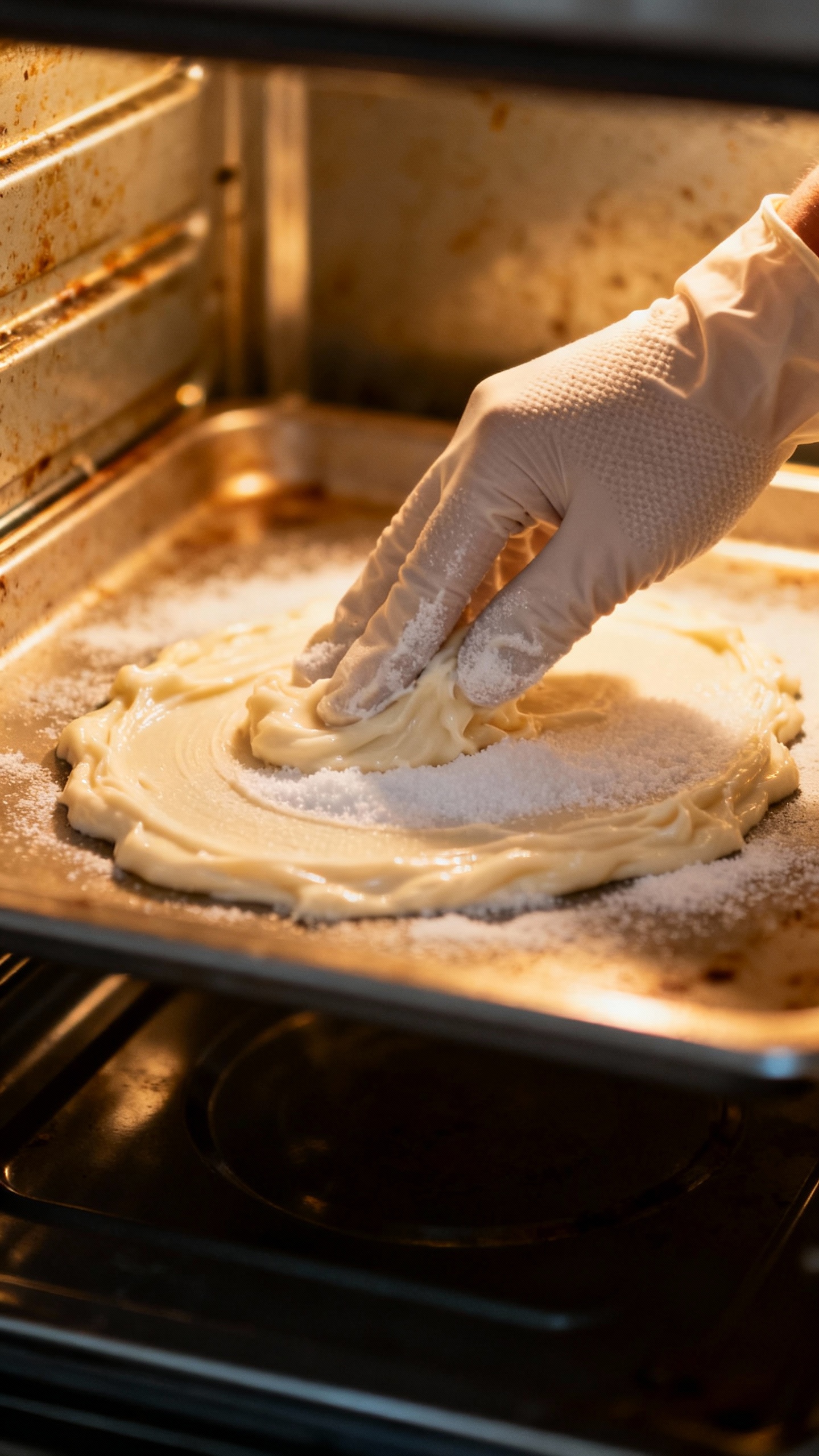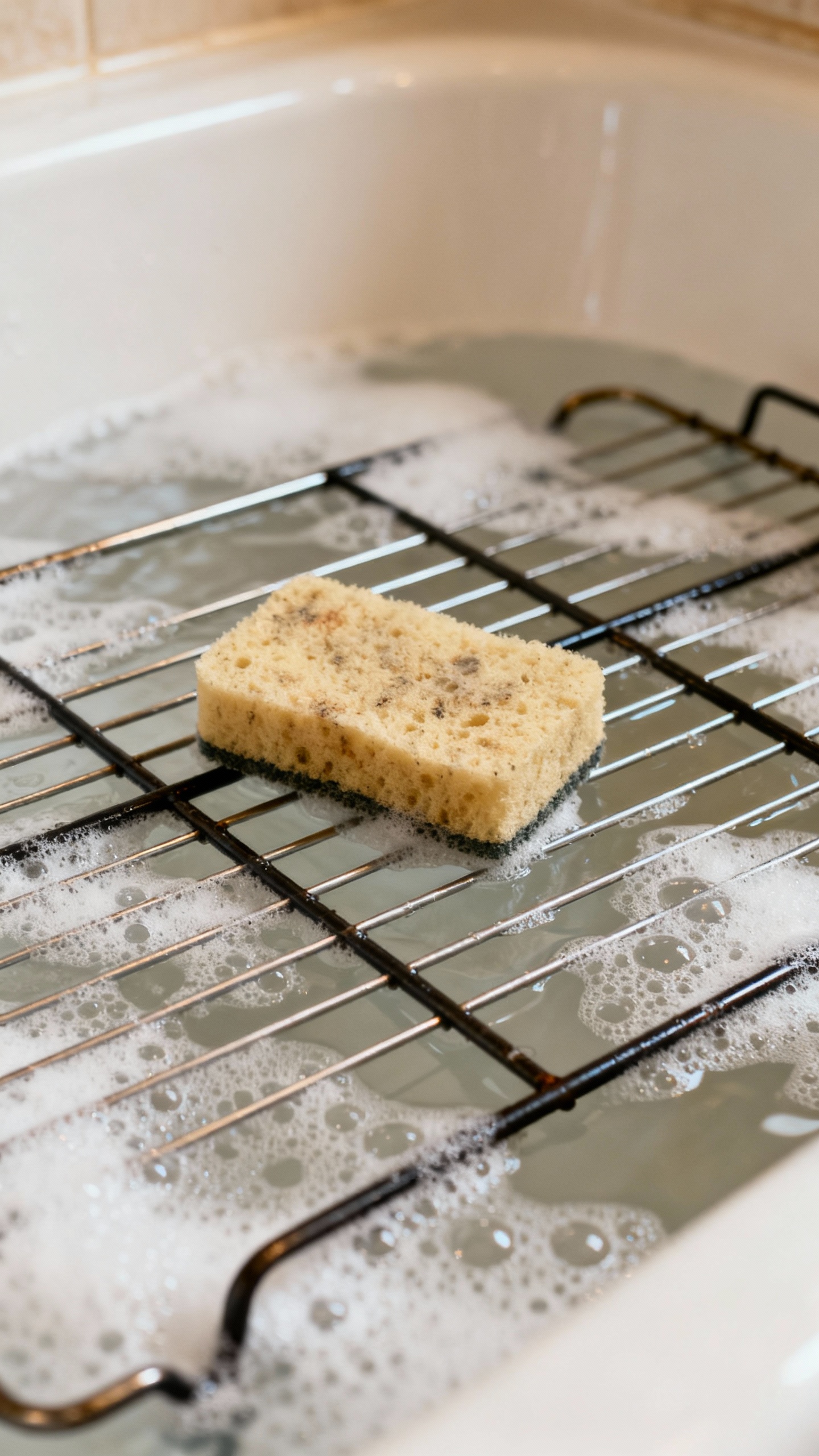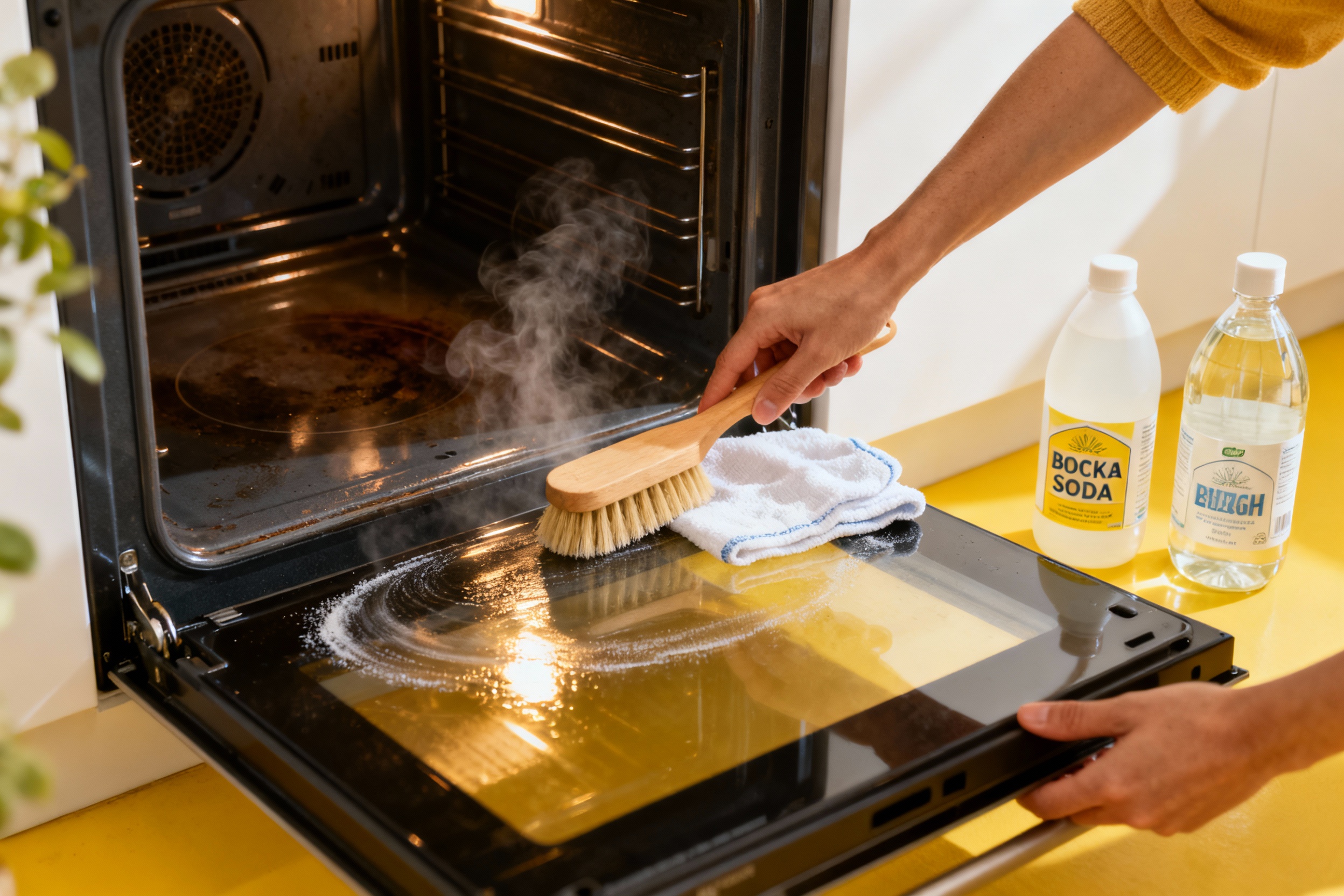Your oven isn’t doomed to smell like last month’s pizza. You can banish baked-on grease and mystery splatters without choking on fumes or wearing a hazmat suit. This method uses pantry staples, a little patience, and minimal elbow grease.
Ready to reclaim that oven?
Why Skip Harsh Chemicals?

You don’t need a can of eye-watering cleaner to get an oven truly clean. Those products work fast, but they leave behind fumes, residue, and sometimes scratched enamel if you go too hard. Plus, natural ingredients like baking soda and vinegar lift grime surprisingly well.
They just need time to do the heavy lifting. Also, your kitchen won’t smell like a haunted swimming pool. Win-win.
What You’ll Need (Probably Already Have It)
Gather your tools before you start so you don’t go hunting mid-scrub:
- Baking soda (at least 1/2 cup)
- White vinegar in a spray bottle
- Warm water
- Dish soap (a few drops)
- Microfiber cloths or old rags
- Plastic scraper or old gift card
- Gloves (optional but nice)
- Small bowl and a sponge
FYI: Skip steel wool on enamel.
It scratches and then grime sticks even worse later.

The Easy, Fume-Free Oven Cleaning Method
Let’s do this step-by-step. I promise it’s simple.
- Remove the racks. Take them out so you can reach every corner. Set them aside for their own spa day.
- Make your paste. Mix 1/2 cup baking soda with a few tablespoons of warm water and a drop of dish soap.
Aim for a spreadable, frosting-like texture.
- Spread the paste everywhere inside. Avoid heating elements and vent holes. Focus on the floor, sides, and back. Use a gloved hand or sponge to smear it around.
- Let it sit for 8–12 hours. Overnight works best.
The paste breaks down grease while you sleep. Magic? No.
Science? Yes.
- Spritz with vinegar. In the morning, spray white vinegar over the dried paste. It will fizz like a tiny volcano and loosen grime further.
- Wipe and scrape. Use a damp cloth to wipe away the paste.
Stubborn bits? Gently scrape with a plastic scraper. Repeat the vinegar spritz as needed.
- Rinse and buff. Wipe with clean water until no residue remains.
Finish with a dry cloth for that “wow” shine.
What About the Oven Door Glass?
Do this while the paste rests inside:
- Sprinkle baking soda on the glass.
- Add a few drops of water until it forms a paste right on the surface.
- Let it sit 15–20 minutes, then wipe clean.
If grease lines live between the two panes, you’ll need to remove the door for access. Check your manual. Sounds scary, but it’s usually just a few screws.
IMO, it’s worth it once a year.
Give Those Racks a Bath
Your racks collect everything: cheese, oil, the occasional breadcrumb fossil. They deserve a soak.
- Lay them in your tub or a large sink.
- Fill with hot water and add a generous squirt of dish soap.
- Optional: Add 1/4 cup baking soda for extra degreasing.
- Soak 1–2 hours, then scrub with a non-scratch sponge.
- Rinse and dry thoroughly before returning to the oven.
No Bathtub? No Problem
Use a large plastic storage bin or line your shower with an old towel to protect it.
Or wrap the racks in old towels, pour boiling water and soap over them, and let them sit in a big sink.
Troubleshooting Stubborn Spots
Some messes laugh at your first attempt. You can laugh last.
- Sticky caramelized blobs: Reapply baking soda paste and a splash of vinegar. Let sit 30 minutes and try again.
- Burnt-on corners: Press a hot, damp cloth on the area for a few minutes to soften, then scrape gently.
- Lingering odors: Heat the empty oven to 200°F (95°C) for 10 minutes with a small, oven-safe bowl of water and a few lemon slices.
- Still streaky? Wipe with a diluted vinegar solution (1:1 with water), then buff dry.
FYI: If your oven has a self-clean mode, avoid combining that with any cleaner residue.
Always remove paste completely first.
Keep It Cleaner for Longer
Think prevention, not punishment. A few tiny habits save you from future marathons.
- Use a sheet pan under casseroles, pies, and pizza. Drips happen.
- Wipe light splatters ASAP after the oven cools.
Fresh mess = easy mess.
- Avoid foil on the oven floor. It can damage enamel and airflow. Use a reusable oven liner if your manual allows it.
- Do a mini clean monthly: Quick wipe with warm soapy water and a light baking soda touch-up.
Natural Alternatives That Actually Work
Not vibing with baking soda?
You’ve got options.
- Lemon steam clean: Slice two lemons into an oven-safe dish, add water, bake at 250°F (120°C) for 30 minutes, then wipe. Great for deodorizing, lighter on heavy grime.
- Salt + baking soda: Mix equal parts for extra grit on sticky spots. Gently scrub, don’t scuff.
- Castile soap solution: A few drops in warm water for regular maintenance wipes.
IMO, baking soda + vinegar still gives the best bang for zero bucks.
FAQ
Can I use this on a self-cleaning oven?
Yes, but keep it gentle.
Use the baking soda paste lightly and avoid abrasive scrubbing on the enamel. Always remove all residue before running a self-clean cycle to prevent smoke or odors.
Will vinegar damage my oven?
Not when you use it correctly. Spray vinegar on the baking soda paste or diluted on surfaces, then wipe and rinse.
Don’t let strong acid sit on metal trim for long periods.
How often should I clean my oven?
Do a deep clean every 3–4 months if you cook regularly. If you bake a lot of cheesy, saucy goodness, every 6–8 weeks. Quick wipe-downs after messy meals stretch the time between big cleans.
Can I clean the heating elements?
Don’t scrub them directly.
For electric ovens with exposed elements, wipe around them carefully with a damp cloth. For gas ovens, keep water away from the igniter. When in doubt, check the manual.
What if the smell lingers after cleaning?
Run the oven empty at 200°F (95°C) with a small bowl of water and lemon slices for 10–15 minutes.
Also double-check you removed all paste. Residual baking soda can leave a dusty odor.
Is it safe to use an oven liner?
Sometimes. Many ovens allow liners on the bottom rack, not on the oven floor.
Check your manual first. Poorly placed liners can block airflow and mess with cooking temps.
Conclusion
You don’t need harsh chemicals to get an oven that looks and smells clean. A simple baking soda paste, a vinegar spritz, and a little patience do the heavy lifting while you do literally anything else.
Keep up with small maintenance and you’ll never dread opening that oven door again. Your next pizza night? Grease drips, meet your match.


